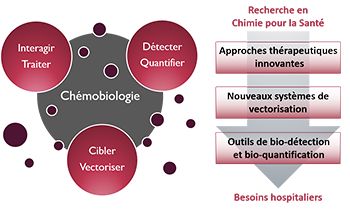- ⌂
-
Le DPM
Les Equipements
L'Environnement
Zoom sur... Le Bâtiment André Rassat
Nommé d'après une figure tutélaire de la chimie grenobloise, ce bâtiment est recouvert d’une double peau en feuille métallique qui apporte une protection thermique sur 3 côtés et crée une unité architecturale favorisant l'intégration parmi les arbres du site.
-
Thématiques
Le Thème
« Approches thérapeutiques innovantes »De nouvelles solutions thérapeutiques, de la cible biomacromolécu-laire émergente aux approches originales pour traiter les maladies
Le Thème
« Nouveaux systèmes de vectorisation »Combiner les propriétés d’inclusion de principes actifs, de franchisse-ment de barrières, d’adressage et de relar-gage en milieu vivant
Le Thème
« Outils de bio-détection et bio-quantification »Des dispositifs analytiques originaux pour la détection de cibles, de l’ion au micro-organisme en milieu complexe
Zoom sur... La Chémobiologie

-
Équipes
L'Équipe « COMET »
« COMET » développe la conception rationnelle, la synthèse et/ou l'extraction de composés à forte diversité/complexité comme nouveaux agents thérapeutiques et outils moléculaires pour la pénétration cellulaire ou la détection de biomolécules, actifs in vivo.L'Équipe « NOVA »
« NOVA » utilise des acides nucléiques fonctionnels comme éléments de reconnaissance pour des applications thérapeutiques ou diagnostiques, comme la sélection d'oligonucléotides, ou le développement de dispositifs d'analyses et de nanovecteurs.Les Services
-
Productions
Les Publications
La Vulgarisation
Les JSM
Zoom sur... La 12ème JSM (15 juin 2023)
Le DPM organise des journées scientifiques consacrées au médicament. L'objectif est de rassembler les spécialistes académiques et industriels autour d'une thématique. 2023 : Apports de la Chimie Click et de la Lumière en Chemobiologie
-
Partenariats
Les Formations
Les Consortiums
Les Financements
Zoom sur... L'environnement Grenoblois
Le DPM est un acteur central sur le bassin grenoblois en chimie, biologie et santé, lié au CHU Grenoble Alpes et à de nombreuses autres organisations : Pole de Recherche CBS, ICMG, Labex ARCANE, EUR CBH, Institut Carnot Polynat, Réseau GREEN.
Article

- Projet
- Denis WOUESSIDJEWE, Annabelle GEZE, Luc CHOISNARD,
- Titre
- Pharmacokinetic study of intravenously administered artemisinin-loaded surface-decorated amphiphilic γ-cyclodextrin nanoparticles
-
[Full paper
 ]
] - Auteurs
- J. Boumbéwendin Gérard Yaméogo, R. Mazet, D. Wouessidjewe, L. Choisnard, D. Godin-Ribuot, J.-L. Putaux, R. Semdé, A. Gèze
- Edition
- Mat. Sci. Engin. C 2020, 106, 110281
- Année
- 2020
- Résumé
- Artemisinin and its derivatives are currently recommended by World Health Organization for the treatment of malaria. Severe malaria requires a parenteral administration of artemisinin-based formulations. However, the effective use of artemisinin is limited by the pharmacokinetic characteristics of the drug (low water solubility, poor bioavailability and short half-life). To overcome some of these drawbacks, artemisinin-loaded surfacedecorated nanoparticles were prepared by co-nanoprecipitation of γ-cyclodextrin bioesterified with C10 alkyl chains and polyethylene glycol (PEG) derivatives (polysorbate 80 and DMPE-mPEG2000). Using a single dose (1.5 mg kg−1 or 2 mg kg−1) by intravenous administration, we investigated the in vivo pharmacokinetic properties in healthy rats of two types of artemisinin-loaded nanoparticle formulations, namely, nanosphere and nanoreservoir systems versus an ethanolic-aqueous solution of artemisinin as reference. Significantly enhanced pharmacokinetic parameters were obtained with artemisinin-loaded nanoparticles. In comparison to reference formulation, the geometric mean exposures in plasma (AUC0-t) exhibited 2.35 and 3.26-fold increases when artemisinin was loaded in nanoreservoir and nanosphere systems, respectively. Its plasma half-life increased 4.00 and 6.25-fold and its clearance decreased up to 2.5 and 4.72-fold. Artemisinin was successfully administered intravenously by means of surface-decorated amphiphilic γ-cyclodextrin nanostructures and showed a longer elimination half-life with respect to an artemisinin solution in ethanol. Therefore, these systems are likely to provide significant advantages for the intravenous treatment of severe malaria.




 Annuaire
Annuaire Contact
Contact Plan d'accès
Plan d'accès ENG
ENG Login
Login



